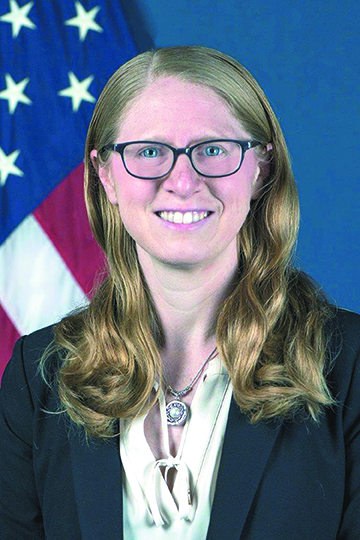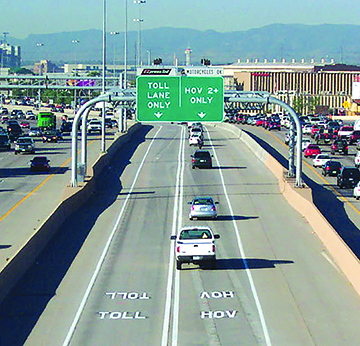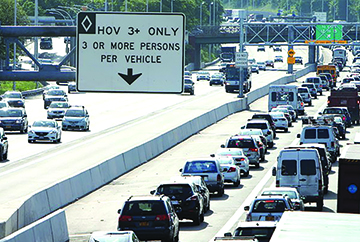Fight Over Unbuffered HOV Lanes Breaks Out At CDOT
by Charles C. Bonniwell

Highly controversial Colorado Department Of Transportation (CDOT) Director Shoshana Lew is leading the agency into adopting unbarricaded/ non-buffered HOV lanes throughout the Front Range, including on I-25, C-470 and I-70. Lanes which — according to individuals who, for obvious reasons, do not wish to be identified for fear of losing their jobs within CDOT — are unsafe for drivers, and whose sole purpose is to provide money for the private companies that are helping to fund the projects. There will be close to 200 miles of highly dangerous roads in the Front Range under Lew’s planning. Originally CDOT created barricaded HOV lanes along U.S. Highway 36 and into and out of downtown Denver on I-25, which proved successful as safe passage for drivers and a good value for those who could afford them.
The purpose of the non-buffered HOV lanes are, according to CDOT, inter alia:
• Making safety improvements to reduce the number of crashes and fatalities.
• Decreasing travel time and increasing trip reliability (at least for those who can afford them).
• Employing congestion management to improve the travel experience.
But disgruntled CDOT employees argue non-buffered lanes accomplish none of the stated goals and, in fact, are being done to satisfy Lew’s increasingly desperate need for money. The state legislature has repeatedly refused to increase CDOT’s funding levels. In the fall of 2019, Colorado citizens turned down, by an 11 point margin, Proposition CC which would have allowed CDOT to use for its purposes the refunds taxpayers would have otherwise gotten under the Taxpayers Bill of Rights.
Extremely bitter about the election results, Lew and CDOT increasingly turned to private investors who would fund the road expansions in so-called Private Public Partnerships or P3s. The investors, all of whom come from outside Colorado, are primarily interested in ensuring a solid return on their investments. They do not view it as their task to worry about the safety of Colorado drivers or their traveling experience. Unfortunately, while CDOT is generally responsible for such concerns, Lew herself does not view private cars as a solution to Colorado’s transportation needs and thus has little interest in the safety and convenience of private car drivers.

Buffered HOV lanes came quickly off the bargaining table. Lew’s HOV lanes would be separated from general purpose lanes simply by a couple of white lines. There was no one at the table to represent the car driving public as noted by some longtime CDOT employees who recognized what was happening.
First and foremost, studies have repeatedly shown that non-buffered HOV lanes do not decrease crashes and fatalities as claimed by Lew and CDOT but, in fact, increase them. A seminal 1979 Federal Highway Administration study found that a lack of physical separation between HOV and general-purpose lanes creates operational and safety problems, causing illegal maneuvers and speed differential between HOV lanes and the adjoining general-purpose lanes.
A study in 2004 published by the Texas Transportation Institute found that non-barrier HOV lanes experienced 41-56% higher injury crash rates compared to barrier-separated lanes. The increased injury crash rates were “likely due to the speed differential between the HOV and the adjacent general purpose lane.”

Similar studies conducted have reached similar conclusions in Virginia, California, Florida, and Minnesota. Because CDOT will, in effect, be putting people’s lives in danger by recklessly adopting non-buffered lanes, some wonder why there hasn’t been at least a debate or public discussion at some level in Colorado government.
Long-term CDOT employees blame Lew whose closed secretive nature is legendary. They view her as an incompetent elitist who believes, like the character played by Jack Nicholson in the movie A Few Good Men, that the public “can’t handle the truth.” Thus, she mandated that the life and death decisions concerning non-buffered HOV lanes should be made outside the public purview by a few CDOT allies of Lew and the out-of-state investors.
Longtime CDOT employees also point out how bad an investment those drivers who use the non-buffered HOV lanes are getting. The non-buffered lanes become incredibly congested during rush hours as frustrated drivers pay little or no attention to the two white lines separating the HOV lane and the adjoining general-purpose lane. There is therefore little or no “decrease in travel time” or “increased travel reliability” or “congestion management to improve the travel experience” for users of non-buffered HOV lanes. As one transportation expert who did not wish to be identified stated: “Why would anyone pay to increase their risk of being hurt in a car crash in a dangerous and often highly congested non-buffered HOV lane.”

Another highly troubling aspect of Lew’s non-buffered HOV lanes is that they are usually only one lane for each direction. If a driver in the non-buffered HOV lane decides to go at or below the speed limit there is no legal way to get around that driver, causing increased incidents of road rage by drivers who paid to be in the HOV lane so they could get to where they wanted to go in a quicker manner.
Lew, CDOT and the out-of-state investors are relying on the doctrine of “sovereign immunity” against the inevitable lawsuits involving drivers getting killed in dangerous non-buffered HOV lanes. Moreover, Lew is reportedly desperate to jump ship and move back to Washington, D.C., where her highly politically connected family lives, and get a job somewhere in the anticipated Biden administration. The carnage she is creating on Colorado highways will, however, last for generations, according to CDOT employees.
